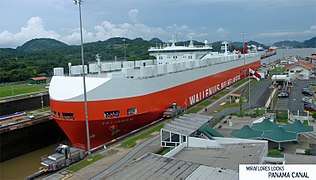Transport in Panama
Transport in Panama is fairly well developed. The majority of the trips are done by car while a great part is done in public transport. The public transportation system is in need of modernization and other improvements.
Railways
.jpg)
There are 76 km of railway track in Panama, as follows:
- broad gauge 5 ft (1,524 mm): used for ship handling tracks along Panama Canal locks (for locomotives, called mules)
- standard gauge 4 ft 8 1⁄2 in (1,435 mm): the 76 km of track were converted from broad gauge (2000).
- narrow gauge 3 ft (914 mm): the 279 km of track are no longer in service, and have been removed.[1]
The first metro line in Panama City was opened in 2014 and the second line in 2019. The metro lines are standard gauge with 1500 V DC overhead electrification.
Road system
- Total: 15,137 km
- paved: 6,351 km (including 149 km of expressways)
- unpaved: 8,786 km (2010)
Panama has well developed highways by Central American standards, with four expressways, all of which are privately owned and require toll payment:
- Corredor Sur: Panama City to the Tocumen International Airport, 26 km.
- Corredor Norte: Panama City to Colinas de Cerro Viento, 20 km.
- Autopista La Chorrera: Panama City to La Chorrera, 44 km.
- Colón Expressway: Panama City to Colón, 59 km.
Furthermore, the Pan-American highway, has been upgraded to a 4-lane, dual carriageway highway from Panama City to Santiago de Veraguas, counting for 248 km of freeway. Also, a small section of the Pan-American highway from Tocumen to Pacora, counting for 18 km has been upgraded to freeway. The same accounts for the Pan-American stretch between David and Capacho, on the border with Costa Rica, adding 55 km of freeway, and for the newly built freeway between David and Bajo Boquete, that extends for 38 km, and for the Chitré - Las Tablas freeway that extends for 30 km.
Panama's roads, traffic and transportation systems are generally safe, but non-functioning traffic lights are not uncommon. Driving is often hazardous and demanding due to dense traffic, undisciplined driving habits, poorly maintained streets, and a lack of effective signs and traffic signals. On roads where poor lighting and driving conditions prevail, night driving is difficult. Night driving is particularly hazardous on the old Panama City – Colon highway.[2]
Buses and taxis are not always maintained in a safe operating condition due to lack of regulatory enforcement. Since 2007, auto insurance has been mandatory in Panama.[3] Traffic in Panama moves on the right, and Panamanian law requires that drivers and passengers wear seat belts, but airbags are not mandatory.[2]
Flooding during the April to December rainy season occasionally makes city streets unusable for most vehicles and washes out some roads in rural areas. In addition, rural areas are often poorly maintained and lack illumination at night. Such roads are generally less traveled and the availability of emergency roadside assistance is very limited. Road travel is more dangerous during the rainy season and in the interior from Carnival through Good Friday. Carnival starts the Saturday prior to Ash Wednesday and goes on for four days.[2]
Waterways

There are 800 km of waterways navigable by shallow draft vessels. The Panama Canal is 82 km long.
Pipelines
The crude oil pipeline is 130 km long.
Ports and harbors
Merchant marine
Panama has an extensive international ship register, comprising 5,005 ships of 1,000 gross tonnage (GT) or over, totaling 122,960,929 GT/183,615,337 tonnes deadweight (DWT). Most of the registered ships are foreign owned, with Panama being a flag of convenience.
As at June 2005, ships by type were estimated as:
|
|
|
The flag of convenience registry includes ships from 71 countries among which are (2005 update):
|
|
Foreign Owned Ships: 4,388
|
|
|
|
As at 2009, Panama dominated the ship registry scene with over 8,065 ships accounting for almost 23% of the world's DWT.
Airports
As at 2006, there were 117 airports in Panama.
Airports - with paved runways
53 airports had paved runways:
- over 3,047 m: 1
- 2,438 to 3,047 m: 1
- 1,524 to 2,437 m: 5
- 914 to 1,523 m: 18
- under 914 m: 28 (2006 est.)
Airports - with unpaved runways
64 airports had unpaved runways:
- 914 to 1,523 m: 11
- under 914 m: 53 (2006 est.)
See also
- Panama
- Panama Railway
- Rail transport by country
References
- "Archived copy". Archived from the original on 2007-03-12. Retrieved 2006-07-01.CS1 maint: archived copy as title (link)
- "Panama: Country-specific information" Archived 2013-12-04 at the Wayback Machine. U.S. Department of State (March 18, 2009).

- "Archived copy". Archived from the original on 2011-09-28. Retrieved 2009-09-01.CS1 maint: archived copy as title (link)
- http://www.copaair.com/
External links
![]()
![]()
.svg.png)